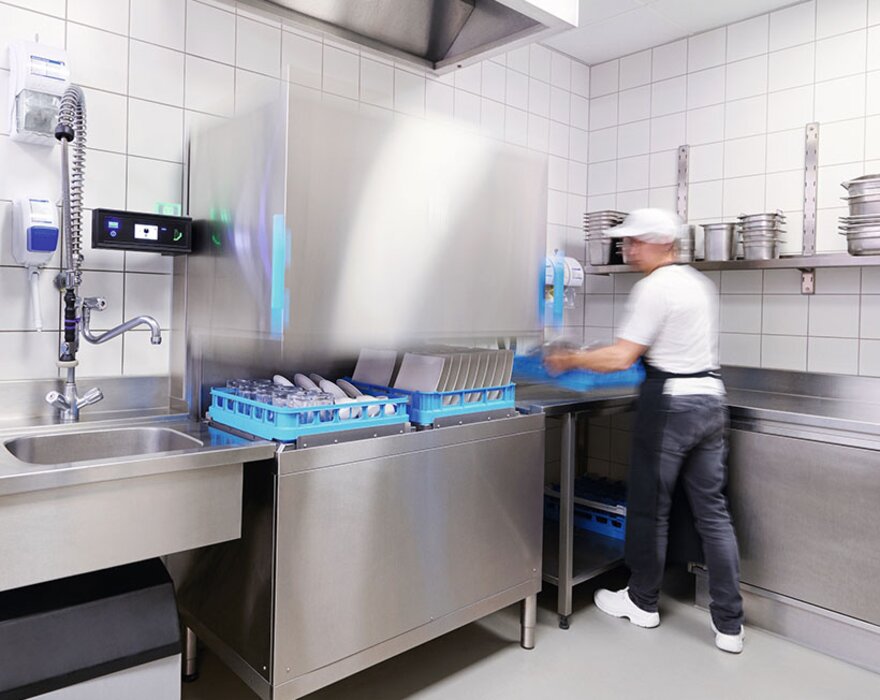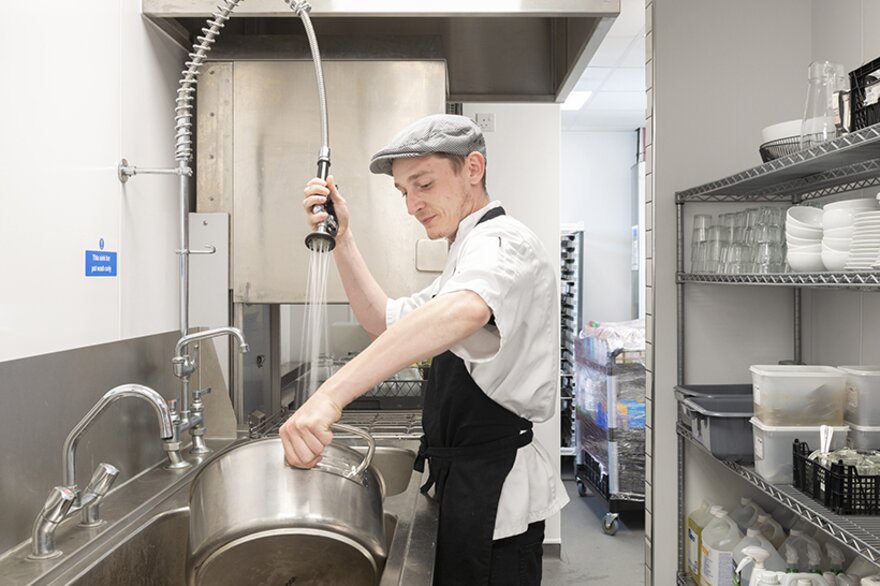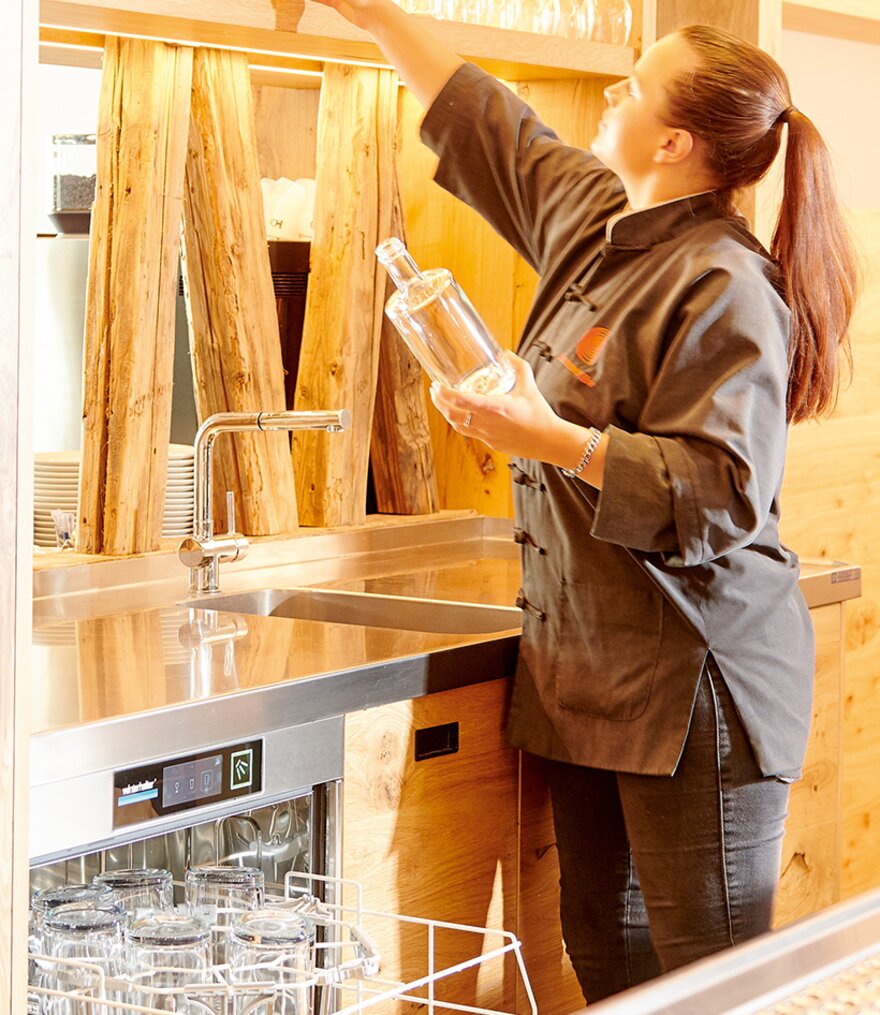Soap stars: the warewashers taking centre stage in the kitchen
A warewasher that not only offers a first-class clean but also looks after your staff wellbeing with light and easy operation should take centre stage in the kitchen. Anne Bruce reports
A good cooking operation doesn't begin and end with the dishes coming over the pass; a five-star cleaning system is also crucial to make a commercial kitchen shine.
If a load of dishes comes out insufficiently clean and needs to be rewashed, that's time, money, and labour costs down the drain. Not all warewashing equipment is equal and choosing the best option for your kitchen will help operators navigate rising costs as well as dried-on stains.
On both economic and environmental grounds, energy efficiency is key. Andy Threlfall, technical and policy director for the Foodservice Equipment Association (FEA) suggests operators should home in on low water consumption when investing in warewashing equipment. Water is heated for each wash cycle, so a machine that uses less water will need less energy to heat the water supply as well as using fewer chemicals.
Energy reduction features, such as heat recovery options and double insulated sides and doors, are also critical, he says. Heat exchangers recycle energy typically lost in steam and wastewater, to heat up the incoming cold-water supply.
Filtration systems can help to lengthen the wash water life and reduce energy consumption further, adds Threlfall. A multi-level filtration system removes debris from the used, hot rinse water so that it can be incorporated into the wash cycle.
Paul Crowley, marketing development manager at Winterhalter UK, also touts a reduction in water usage as a way to significantly reduce running costs. Winterhalter's latest undercounter machine has a redesigned wash arm, including changes to the water channels and jets to optimise the water flow and create an optimised washfield. This improves the wash results and reduces water consumption by 25%, leading to a 22% reduction in overall running costs, he says.
John Nelson, managing director of Nelson Dish & Glasswashers, says shallow wash tanks requiring less water and high levels of insulation to prevent heat loss are also ways to reduce energy consumption. Nelson's Advantage AD40 machine, which comes either as a dishwasher or glasswasher, uses seven litres per wash cycle. Of those seven litres, only 2.14 are freshly drawn rinse water.
Air force
The latest version of Winterhalter's passthrough hood dishwasher, the ClimatePlus, offers another smart solution by acting as an air conditioner. The technology draws hot air from the kitchen environment and uses it to heat incoming cold water, before pumping cool, dry air back into the kitchen.
Prioritising staff wellbeing by creating a good work environment is key, with staff shortages across foodservice increasing chances of kitchen staff being poached by rivals.
M-iClean's HXL double basket dishwasher has an automated double hood which raises or lowers with a touch of the control panel. Previously, workers needed to be strong enough to repeatedly lift and lower the hood and tall enough to push it to the top of its travel. With this model, the dishwash operator loads the next racks while the hood descends, rather than having to heave it down.
Meiko UK managing director Paul Anderson says: "One of the things we discovered is that it takes 80 newtons of force, or roughly 8kg, to manually open a hood type machine. That's a substantial workout when the hood needs raising many times a day – 120 times in a busy shift is not unusual."
Staff-friendly and energy smart solutions don't have to be complex, says Chris Mansell, warewash product manager at Hobart UK Equipment. "One of the simplest, value-for-money features we have created is a double rack insert accessory on our undercounter dishwashers that doubles the machine's capacity in the same single wash cycle and effectively halves the consumption per rack. It's a very small outlay, but if an operator stacks the machine correctly, they could halve their operating spend, as fewer cycles reduce labour, servicing and maintenance outlay too."
The rack insert can be placed in and taken out with one hand, he says.
Warewasher racks are having to accommodate new demands as well. Glass bottles and reusable plastic ones are the order of the day in 2023, with operators looking for alternatives to single-use plastic. Meiko offers a bottle wash rack and adapter for use on Meiko's M-iClean UM/UM+ undercounter machines, which swaps with the standard wash rack.
The Meiko system takes all standard bottles and washes 16 simultaneously. Meiko also supplies a rack to help wash lightweight and reusable cups.
Fantastic plastic
Winterhalter has also developed special systems to wash reusable plastic cups and bowls. Plastics can be challenging to clean and dry in commercial dishwashers, says Crowley. "They can flip over, fill up with water and high heat can damage the plastic. Plastic requires different chemicals to guarantee safe and effective cleaning and to ensure they dry quickly to speed up handling, storing and stacking after the wash."
The new system uses special racks that hold plastic cups, bowls or plates in place, a smart wash program to ensure the temperature is right for the ware, and dedicated cleaning chemicals to facilitate a quicker dry.
Alongside the warewasher racks, cleaning agents are also changing with the times.
Supplier Sybron has launched SyBio detergent and SyBio rinse aid, its own range of concentrated biotechnology-based warewasher products which use fewer chemicals than standard products. These are suitable for use in both dishwashers and glasswashers, allowing operators to streamline products from four to two, simplifying stock management.
Aside from the spec of the warewashing machines and chosen detergents, there are several more basic considerations to bear in mind: space, power supply and noise levels.
Threlfall suggests that before selecting the right model you need to assess what space is available for the warewasher, how many plates or glasses you need to wash per hour, and types and sizes of plates or glasses.
"An undersized machine will lead to premature failure and poor wash performance. One that's too big will waste consumables, including energy," he says.
For your warewash area to work effectively, you also need to factor in the need to scrape the plates and pre-rinse them before putting them in the washer. Water pressure, water quality (hardness), electrical power supply requirements, and drain options are also important factors to consider.
Where space is an issue, there are compact, high-capacity models to process a large volume of dishes or glasses. Nelson's AD50 ‘Compact' Advantage is capable of washing 2160 glasses (or 90 covers in the dishwashing version) per hour but is 720 mm in height.
Quiet operation is important if a dishwasher has a front of house siting and Nelson Advantage glasswashers operate at 58 dBs, a sound equivalent to gentle rainfall.
Train up to avoid breakdowns
Last, but by no means least, looking after the machine is vital, says Threlfall. Check what training the supplier provides to ensure staff understand the routine maintenance required. Make sure you take out a maintenance contract to keep the unit in top condition, he urges. Kitchens can often be the victims of high staff churn, so it is imperative that new team members are brought up to scratch quickly.
"Training needs to be offered to get new staff up to speed on best practice, helping avoid costly breakdowns, which can be brought on by seemingly innocuous things like the incorrect loading of baskets," says Mansell.
The good news for operators is it may soon become easier to weigh up different models. Currently many types of professional food service equipment, including commercial warewashing, fall outside the scope of the A to G energy classification to help buyers select the best model, says Threlfall.
But warewashers are one of the product groups recently added to the government Energy Technology List (ETL) scheme. The rigorous testing required to appear on the list covers not just energy consumption but also cleaning results plus, a new hygiene test to ensure the warewasher not only cleans but can meet hygiene standards in accordance with the new BSEN17735 standard.
"We are still waiting for warewasher manufacturers to appear on the list. Once that happens the ETL will be the first place to look for energy efficient products," says Threlfall.
Warewashers are big users of resources, energy, water, and chemicals, so if your current model is guzzling more than just dirty plates it might be time to start looking around for a model that could freshen up your kitchen.
Suppliers
Foodservice Equipment Association (FEA) www.fea.org.uk
Hobart UK Equipment www.hobartuk.com
Meiko UK www.meiko-uk.co.uk
Nelson Dish & Glasswashing Machines www.nelsonwashonline.co.uk
Sybron www.sybron.co.uk
Winterhalter UK www.winterhalter.com/uk-en/
Continue reading
You need to create an account to read this article. It's free and only requires a few basic details.
Already subscribed? Log In





